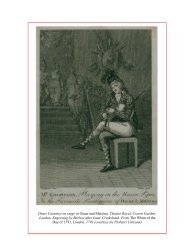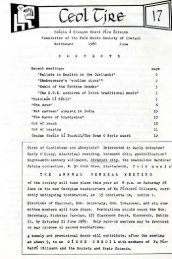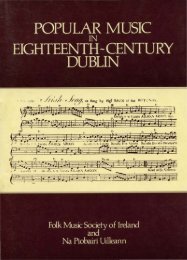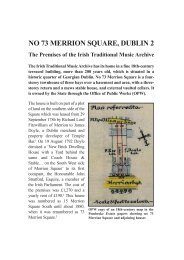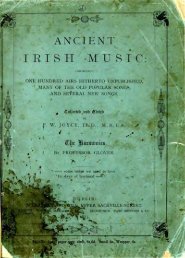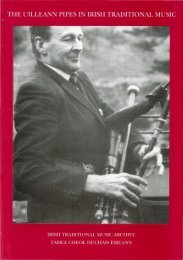Union Pipes - Irish Traditional Music Archive
Union Pipes - Irish Traditional Music Archive
Union Pipes - Irish Traditional Music Archive
Create successful ePaper yourself
Turn your PDF publications into a flip-book with our unique Google optimized e-Paper software.
95<br />
SOMe COnSIDerATIOnS ArISIng<br />
If Denis Courtney’s ‘union pipes’ were not then in fact a new<br />
instrument, but a new name for an existing instrument, there is a need<br />
for some revision of bellows-bagpipe terminology as used hitherto in<br />
bagpipe studies and museum catalogues. In such sources ‘union pipes’<br />
has often been used as a convenient term to distinguish the earlier<br />
eighteenth-century bellows legato bagpipes with a foot-joint, of the<br />
1740s ‘pastoral’ type, from the later bellows pipes with a stoppable<br />
end-tenon and a staccato capability, supposedly of the ‘union’ type.<br />
Without doubt players and makers after Courtney’s time did use his<br />
term to refer to bellows pipes of this latter type, but it cannot be accurately<br />
used to label all such bellows pipes, and certainly not those that<br />
pre-date his death in 1794, unless there is future agreement among<br />
organologists to employ it deliberately as an ahistorical but convenient<br />
diagnostic term, much as <strong>Irish</strong> writers now use ‘uilleann pipes’ for<br />
forms of the instrument in existence before 1903.<br />
Discussions of bellows pipes in Britain and Ireland have frequently<br />
been bedeviled by the lack of a clear chronology for the history of the<br />
various forms of the instruments. It is hoped that the unrolling above<br />
of a chronology for terms used for the <strong>Irish</strong> bellows pipes, indicating<br />
as it does both exact moments of change and of less exactly datable<br />
trends in terminology, will provide a scaffolding for greater projects:<br />
for the building of an accurate chronology for the physical development<br />
of the instrument itself, and the compiling of a history of its performance<br />
practice. here the best hope still remains a programme of<br />
detailed organological description of older surviving sets, newly contextualised<br />
by contemporary information about the instrument which<br />
continues to emerge from ongoing print digitisation projects and also<br />
by the surprising number of visual illustrations of early instruments<br />
and piping practice that have recently come to light. This programme<br />
will be animated by the large body of sound and video recordings of



